Recommended Varieties/Cultivars
Arugula is available in a surprising range of appearance, degree of spiciness, flavor, texture, and other characteristics. Generally "common" or "salad" strains are milder in flavor with rounded and paler leaves; while "wild" strains are often spicier with longer, thinner, deeply lobed leaves that may have more prominent midribs and veins.
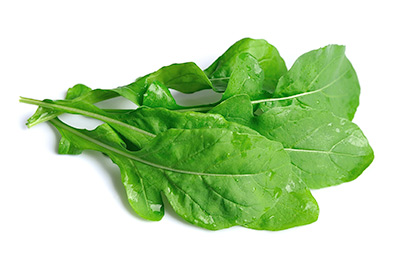
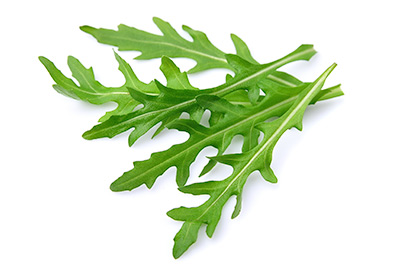
No arugula is truly heat tolerant, but Astro is reliable, early, and more heat-tolerant than most other varieties. It's relatively mild in flavor, and a good choice for areas where there is a possibility of unseasonal heat waves. Rocket is spicier and produces yellow edible flowers rather than the more common white.
Sylvetta is a popular, pungent "wild" arugula variety. Olive-Leaved Sylvetta is slow-growing and very strong-flavored, with a long, narrow leaf. Other recommended wild varieties include Selvatica, which is somewhat heat tolerant with a strong flavor. Dragon's Tongue is appealing and unusual with prominent purple veining.
Buying/Selection Tips
Arugula does not transplant well and generally should be seeded directly, either broadcasted or seeds planted individually. GardenZeus recommends against transplanting arugula unless you are an experienced biointensive gardener or able to closely monitor seedlings. See "Advanced Tip" in the GardenZeus section "Special Care, Needs, and Tips" for tips about transplanting.
Some nurseries may happily sell you cell packs or transplants of lush-looking arugula seedlings, but when transplanted these may tend to result in slow-growing plants that may be more prone to pest-and-disease problems, early bolting, and a disappointing harvest.
Soil Needs/Tip
Arugula prefers reasonably fertile, uniform, well-drained soil with sufficient nitrogen and moderate-to-high organic matter, but will tolerate a wide range of soil conditions and produces reasonably well in many difficult soils. It performs well in soil pH of about 6.0 to 6.8, and may tolerate more acidity and slight alkalinity, but at pH extremes it may not grow quickly or produce high-quality leaves.
Suitable Microclimate
Ideal growing conditions for arugula are full sun at about 50° F to 65° F. Most varieties seem to tolerate intermittent, short periods of warmer weather, but arugula will bolt in response to ongoing periods of warm-to-hot weather. While less fussy about soil than most vegetables, arugula performs best with consistent soil moisture.
A southern or western exposure with full sun is best from fall through late winter, with a southern or southeastern exposure often best from late winter through late spring.
Ideal conditions during warm-to-hot weather are full sun in the morning and bright shade for the remainder of the day. To extend your harvest and avoid overly spicy leaves, you may wish to install 30% shadecloth over your arugula plants to protect them during warm afternoon temperatures, or be creative in finding ways to provide shade, such as with trellises, clothes lines, outdoor furniture or canopies, or palm fronds. Consider constructing mobile screens, frames, or lightweight cages made of wire with shadecloth, screening, or old sheets. These can be bent over beds to form tunnels or bent at custom angles to provide custom areas of shade. Varied densities of cloth or screening materials can be used to provide custom levels of brightness and shade.
Getting Started
Arugula is among the easiest and fastest-growing garden greens. When soil moisture is reasonably consistent and temperatures are seldom above about 70° F, it tolerates many otherwise adverse conditions.
It's best to start arugula from seeds directly in beds or containers and avoid transplanting, unless you are an experienced biointensive gardener or able to closely monitor seedlings. See "Advanced Tip" in the GardenZeus section "Special Care, Needs, and Tips" for tips about transplanting.
Arugula seeds are generally easy to germinate. It’s best to sow seeds in a sunny area when daytime temperatures are consistently below 75° F. For a continuous harvest, estimate how many arugula plants you use every 2 to 3 weeks, then start about twice that many seeds every 2 to 3 weeks. After losing a portion of your plants to thinning, bugs, and garden mishaps, you should have a steady supply of arugula in about the amounts that you prefer.
Arugula is highly recommended for new gardeners or those who have struggled with other crops, and is a fun and easy crop to grow with children.
Watering Tips
Arugula needs moist-but-not-wet soil to produce consistent and rapid growth. It generally requires regular watering, especially in sandy or light soils. In clay and heavy soils, water more slowly over time to encourage infiltration to the full depth of the roots.
Water arugula using drip or surface irrigation rather than sprinklers whenever possible to minimize problems with pests and diseases. Arugula has the reputation of being shallow-rooted, and even more so in alkaline and compacted soils, but it can grow deeper root systems in loose, fertile soils. Water progressively more deeply and less frequently without ever allowing soil to dry or arugula plants to wilt between waterings. This will encourage deeper rooting that will help plants to produce abundant yields and to tolerate periods of warm weather.
Planting Method/Tips
Arugula is easy to grow from seeds and should be seeded directly. Seeds can be broadcast outdoors or planted one at a time and covered with a very thin (1/8-inch) layer of fine soil or sand. Broadcasted seeds must be kept moist for germination, which may require misting or watering with a gentle, fine spray more than once per day.
Arugula germinates well at temperatures from about 40° F to 80° F, often 3 to 7 days at warmer temperatures and 6 to 15 days at cold temperatures. Arugula plants produce the best-quality and most-tender leaves at temperatures between about 50° and 65° F.
Avoid planting arugula in soils or beds where other brassicas, such as turnips, cabbage, kale, broccoli, cauliflower, and brussels sprouts, have grown within the past 2 years (the longer the better).
GardenZeus generally recommends against transplanting arugula; even dedicated biointensive gardeners generally seed arugula directly. It is possible to transplant arugula successfully; see "Advanced Tip" in the GardenZeus section "Special Care, Needs, and Tips."
Spacing
Spacing varies by variety, frequency of harvest, and purpose or use for the plants. For earlier, larger, and highest-quality harvest, GardenZeus recommends broadcasting arugula seeds or planting 1 to 2 inches apart, gradually thinning entire plants beginning about 1 to 3 weeks after germination, and harvesting outer leaves of established plants as needed and while still tender rather than waiting to harvest entire mature plants.
Final spacing of 6 to 8 inches is usually sufficient for established arugula plants whose outer leaves are harvested regularly. For larger plants or to grow edible flowers and/or for saving seeds, final spacing may vary from 6 to 18 inches.
Timelines
3 to 15 days to seed germination, often 3 to 7 days at warmer temperatures and 6 to 15 days at cold temperatures.
GardenZeus generally recommends that arugula be seeded directly rather than transplanted.
About 10 to 21 days to earliest harvest of thinned plants for greens.
About 18 to 30 days for early harvest of baby leaves.
About 20 to 50 days from germination to harvest of full-sized leaves and mature plants, depending upon variety and growing conditions.
Pollination Needs/Tips
Because we eat the leaves of arugula, we prefer slow flowering (slow bolting), and are generally not concerned with pollination unless saving seeds.
Arugula is self-sterile and must be pollinated by insects to produce seeds. It does not cross with other brassicas, but will cross with other arugula varieties.
Interplanting/Companion Planting
Avoid planting arugula in soils or beds where other brassicas, such as turnips, cabbage, kale, broccoli, cauliflower, and brussels sprouts, are currently growing or have been growing within the past 2 years.
Brassicas are traditionally considered antagonists of pole beans, strawberries, and nightshade vegetables such as tomatoes, peppers, and eggplants.
GardenZeus expert Darren Butler has found arugula to be a generally unfussy companion for most vegetables, and that companion planting for arugula is of minimal concern as compared to issues such as consistent soil moisture, soil pH, compaction, and sufficient soil nitrogen. It may benefit from being planted near herbs such as sage, dill, and chamomile, and seems to get along well with many other herbs and vegetables, including bush beans, cucumbers, onions, and potatoes.
Nutrient/Amendment/Fertilization Needs/Tips
Arugula will generally do well in most loose soils with sufficient nitrogen, mildly acidic pH, and reasonable organic matter. GardenZeus recommends adding nitrogen in the form of diluted urea or a cup of chicken manure diluted in 4 gallons of water (half cup if fresh manure) and mixed thoroughly, applied as a soil drench once when arugula sprouts are about 2 inches tall, and about 1 to 3 times per month thereafter while actively harvesting leaves. Adding too much nitrogen or overly rapid growth of high-nitrogen leaves may result in insect infestation or disease.
Mulching
Use 1/4-inch fine mulch for starts when they reach 1 to 3 inches in height; increase to half-an-inch or more of fine-to-medium mulch after plants are at least 4 to 5 inches tall.
Pruning/Cutting Back/Pinching/Separating
GardenZeus recommends harvesting outer leaves of arugula while still tender and as needed, which allows the plant to produce new leaves over an extended period from the growing point at the plant's center. Progressive thinning of plants may be needed, but arugula is otherwise not normally cut back except for harvest of edible flowers or entire plants, such as anytime a large quantity of arugula is needed or prior to warm weather.
Propagating
From seed. GardenZeus recommends open-pollinated, untreated, organically grown seeds.
Container Gardening
All varieties of arugula are suitable for growing in containers. Pots or containers for growing arugula should be of at least 6 inches in depth; 10 to 12 inches or more is preferable.
Arugula is an ideal plant for container gardening. Containers allow you to move arugula to follow seasonal changes in sun, to shaded areas during warmer weather, to warmer areas during winter, and to protected areas when necessary in response to winds or other environmental factors.
GardenZeus recommends a soil mix of at least 2/3 sand and topsoil when growing arugula in containers, with some organic matter or compost. Potting soils with high proportions of organic matter tend to shrink and collapse over the course of a growing season as soil microbes and macro organisms like insects digest or decompose the organic matter, which results in falling soil levels.
Arugula is sensitive to drying soil, especially in warm weather, and will wilt easily, which can reduce leaf quality, shorten the harvest period, and lead to premature bolting. Soils may dry rapidly in containers, so monitoring and regular watering of arugula in containers is important. Pay close attention to soil moisture and frequency of irrigation, and be sure to water sufficiently to avoid any signs of wilting. If you know you may have difficulty maintaining consistent soil moisture, consider using self-watering containers, which have a reservoir of water and a wicking mechanism, such as cloth or soil tubes. These can be purchased or made yourself.
Seasonal Care
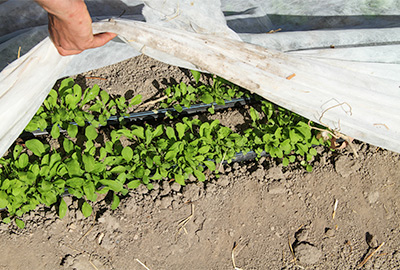
Arugula is a cool-season crop that produces the best-quality and most-tender leaves at temperatures between about 50° and 65° F. In the warmer inland valleys in California, arugula is grown from fall through spring, while in coastal areas of California, arugula may be grown year around. Arugula generally withstands mild overnight frosts, and requires protection in the form of cloth, plastic, or cardboard sheets only when temperatures dip down below about 26° or 27° F.
Seed arugula directly when daytime temperatures are consistently below 75° F. Stagger plantings of arugula every 2 to 3 weeks for a continuous supply.
Arugula bolts in response to heat, insufficient moisture, repeated wilting, and may bolt in response to other stressors, such as being rootbound in small containers or overharvesting. It also bolts naturally at the end of its lifecycle.
How to Harvest
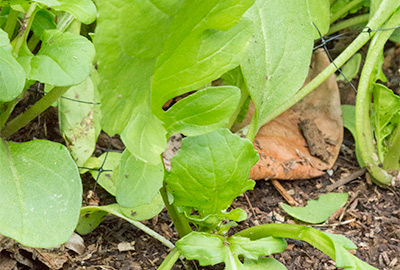
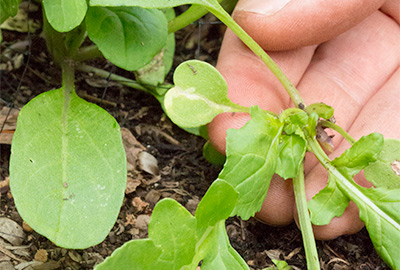
Harvest thinnings beginning 10 to 21 days after germination. Under good growing conditions and with sufficient soil nitrogen, baby leaves can be harvested individually beginning 18 to 30 days after germination.
Arugula leaves are the most tender when small and young, from 2 to 4 inches long, and generally are of reasonable eating quality when 2 to 6 inches long. Leaves longer than about 5 to 6 inches tend to be tougher and stronger in flavor.
Use a sharp knife or garden scissors to cut the largest, outermost leaves at the base of their midribs near where they join the crown of the plant. Use care to avoid damaging the growing point at the center of each arugula plant, from which new leaves are produced for future harvesting. Younger, smaller, and more tender leaves can often be pinched off by hand. If outer leaves are large or less tender, leave them on the plant and harvest leaves farthest from the growing point that are sufficiently tender.
To maximize total yield, GardenZeus recommends restrained harvesting until arugula is several inches tall to avoid stunting plants by aggressive early harvest. GardenZeus recommends harvesting about 10% to 20% of arugula leaves every 6 to 12 days from vigorous, actively growing plants. Overharvesting will significantly slow growth of new leaves because the plant is using leaf surfaces to capture the energy needed to grow new leaves, and may stress the plant and encourage early bolting.
Entire plants can be harvested by cutting near the soil line. If pulling entire plants from soil, use caution to avoid disturbing the root systems of nearby plants.
Harvesting Tips
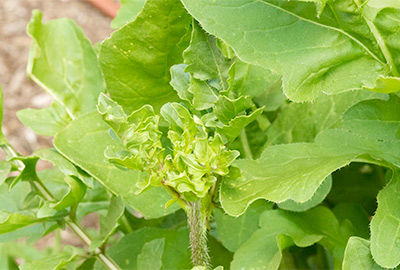
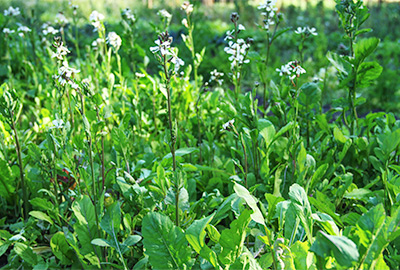
Depending upon variety, temperature, stress to plants, and growing conditions, arugula may bolt quickly before or after reaching maturity, or may provide an ongoing cut-and-come-again harvest for periods of at least a few weeks. To extend harvest, maintain consistent soil moisture, apply mulch to soil, protect plants with shade during hot weather, and avoid harvesting more than 10% to 20% of a plant's leaves at one time. Ideal growing conditions can be difficult to provide in your zone due to unseasonal heat waves from fall through spring.
Arugula produces new leaves from a central growing point in a manner similar to lettuce. When the plant begins to bolt, a flower stalk will appear at this growing point. As you get to know the variety of arugula that you're growing, you may develop intuitive timing for when to harvest entire plants prior to bolting; otherwise harvest aggressively at the first sign of bolting. Some varieties of arugula may be unpalatable by the time bolting begins. In others, it may be possible extend the harvest of individual leaves slightly by cutting off flower stalks as soon as they appear.
Warm-to-hot weather or insufficient watering may result in stronger leaf flavor or bitterness. Provide shade during warm afternoons to extend harvest.
When arugula begins flowering, leaf quality for eating declines rapidly and often by the time it is in flower, the leaves are inedible. Fortunately with arugula, there is a silver lining: flowers are edible and make a lovely addition to fresh salads.
What Commonly Goes Wrong
Unseasonal planting and hot weather: Arugula is a cool-season crop and suffers at temperatures above 75° to 80° F. Ongoing temperatures above 75° F, or shorter periods at higher temperatures, may cause a range of issues including bolting, stronger-flavored and tougher leaves, and pest or disease infestation. Generally arugula should not be planted when daytime temperatures are consistently above 75° F.
Bolting: Arugula bolts most commonly in response to warm or hot weather, uneven soil moisture, wilting, or soil dryness. Overharvesting, rootbinding, and other stressors may also encourage arugula to bolt early. There is nothing that can be done to reverse or stop bolting once it begins; it may be possible to extend harvest slightly by cutting off flower stalks as they appear. GardenZeus recommends tasting leaves for quality and if still reasonable, harvesting the majority of leaves or whole plants at the first sign of bolting, unless you want to save seeds.
Strong flavor or bitterness in leaves: Usually the result of warm-to-hot temperatures, insufficient or uneven watering, or bolting. These issues may also result in slow or no growth, small plants, and small leaves.
Slow growth, lack of vigor, small plants and/or leaves, production of few leaves, yellowing leaves, dried-out or brown leaves: These common symptoms may result from soil pH that is too high or too low, compacted soil, alkaline soil, overwatering, underwatering, irregular watering or drought stress, poor drainage, warm or hot weather, frost, lack of soil nitrogen, other soil nutrient deficiencies, soil infertility, or a combination of these. They may also be the result of wind or other environmental and abiotic stressors.
Brown and dead leaf tips or edges: Burned leaf tips often result from over fertilizing, sodic soils, animal urine, over application of manure or urea, or soluble salts in soils.
Tall and/or gangly plants with long and/or sparse leaves: This is called "legginess" and is usually the result of shade or insufficient sunlight. Leaves may be unusually dark green. Arugula prefers full sun at cool temperatures.
Wilting or blemished flowers, dropped blooms: May be caused by frost, lack of water, lack of pollination, or other environmental stressors.
Overwatering and wet soils: Arugula becomes stressed and susceptible to pests and diseases as a result of poor drainage or standing water. In poorly drained soils, it is possible for the soil surface to be dry but water to be perched or pooled beneath the surface.
Shallow roots: In compacted clay soils that are common in new gardens in your area, arugula may form extremely shallow root systems with plants that appear vigorous and healthy until warm weather arrives and upper soil layers heat up, after which arugula may bolt, decline, or die rapidly. Break up compacted soil before planting, amend with compost, maintain surface mulch, and water slowly and less frequently to encourage deeper rooting.
Chlorosis is iron deficiency that appears as lightening or yellowing between veins on older leaves and/or pale-green or yellow new leaves. Affected leaves will never return to normal because iron is not a mobile nutrient, meaning that it cannot be relocated within a plant. Alkaline city water and alkaline soils are common causes of chlorosis; iron becomes decreasingly available to plants when soil pH is above 6.0, and is mostly unavailable at pH of 7.0 and above. Applying chelated iron can help temporarily but is not a long-term solution or cure, and chelated iron may rapidly become unavailable in alkaline soils. The best solutions are to encourage a thriving, healthy soil ecosystem that will naturally improve pH; provide acidity to soil by watering with diluted vinegar at proportions of about 1/4 to 1/2 cup of white vinegar in 2 gallons of water; or use an acidifying product such as pH Reducer.
Not a Problem
Naturalizing: Arugula will readily propagate itself by seed and may even spread around your garden like a weed if you allow it to bloom and set seeds.
Mildly bug-eaten leaves: Flea beetles relish arugula leaves, and various other garden pests may also graze on them. Often the vast majority of bug-shared leaves are still in reasonable shape for human use. If you're squeamish about imperfect produce, consider cooking the bug-bitten leaves.
Arugula may have a comparatively short period of leaf production, especially during warm-to-hot weather. Plants may bolt quickly upon reaching maturity. GardenZeus recommends successive planting of smaller quantities of arugula every 2 to 3 weeks or as needed throughout the growing season to produce a steady harvest.
Common Diseases
Most arugula disease problems can be avoided by planting during appropriate temperatures in well-drained, reasonably fertile soil with an active soil ecosystem; rotating crops or avoiding planting where other cole crops were grown within the past 2 years; avoiding excess application of nitrogen; and otherwise meeting the plants' cultural needs, especially with uniform and sufficient watering without overwatering.
Damping Off: A common soilborne fungus that may suddenly kill smaller seedlings and starts. Occurs most commonly in cool, damp soils.
Mildews: Powdery and downy mildew are probably the most common leaf-diseases of arugula. They appear as whitish circles or whitish layers on the upper or lower surfaces of leaves, yellowing or dead spots, or pale or yellow angular leaf sections, and may be mistaken for other problems, such as nutrient deficiencies. Powdery mildew is especially prevalent later in spring or after periods of hot weather. Avoid wetting foliage when watering, and water early in the day to avoid plants being wet overnight.
Some mildews can be discouraged using a nontoxic homemade spray of one tablespoon each of baking soda and tea tree oil per quart of water, shaken vigorously and regularly and applied via spray bottle. Mildews are often difficult to control and are best managed through prevention and good cultural practices, such as planting resistant varieties, allowing extra space between plants, planting in areas with good air circulation, keeping foliage dry, less-frequent irrigation, encouraging biologically active "living" soil that will support strong plant immune systems, and rotating crops.
Mildews are often not fatal and arugula may produce reasonable yields and fresh uninfected leaves despite ongoing infections on older leaves.
Common Pests
Flea beetles are small jumping beetles. They feed on the leaves of many garden greens and vegetables, including arugula, leaving pits or small holes, often with brown or dead margins or spots. Like many insect pests of cool-season crops, they tend to be problematic mostly during warm-to-hot weather and/or when plants are stressed for other reasons, such as insufficient or inconsistent watering.
Aphids occur more often in spring to summer or during warm weather than from fall through winter or during cool weather. They can sometimes be removed with a strong stream of water, or washed off leaves with a cloth or rag before plants become fully infested. Aphids are often associated with Argentinian ant infestations; ants move the aphids to uninfested leaves and plants, and fight off predatory insects in return for harvesting the honeydew that aphids excrete. Control the ants using a boric-acid ant bait.
Cabbage loopers: Green caterpillars that may skeletonize leaves or leave large holes and ragged sections in leaves. In home vegetable gardens they can often be handpicked.
Other common pests of arugula in your zone include cutworms, leafminers, bagrada bugs, harlequin bugs, grasshoppers, earwigs or pincerbugs, sowbugs or potato bugs (especially for young starts or transplants), caterpillars, thrips, whiteflies, snails, slugs, gophers, wild rabbits and hares, and deer. Caterpillars tend to skeletonize leaves (remove all the leaf matter except veins and midribs), while slugs, snails, and earwigs tend to eat holes or ragged areas in otherwise intact leaves.
Special Care
For a continuous harvest, estimate how many arugula plants you use every 2 to 3 weeks, then start about twice that many seeds every 2 to 3 weeks. After losing a portion of your plants to thinning, bugs, and garden mishaps, you should have a steady supply of arugula in about the amounts that you prefer.
To extend your arugula harvest, provide shade on warm afternoons. As weather warms, you may wish to install 30% shadecloth over your arugula plants to protect them during warm afternoon temperatures, or be creative in finding ways to shade arugula and extend harvest, such as with trellises, clothes lines, outdoor furniture or canopies, or palm fronds. Consider constructing mobile screens, frames, or lightweight cages made of wire with shadecloth, screening, or old sheets. These can be bent over beds to form tunnels or bent at custom angles to provide custom areas of shade. Varied densities of cloth or screening materials can be used to provide custom levels of brightness and shade.
To maintain uniform soil moisture for arugula it may help to keep a full watering can near your arugula beds or containers and give them small amounts of water every 1 to 3 days, especially if they are planted here and there in odd areas throughout your garden or near plants that need less-frequent watering.
Special Info
Arugula does not cross-pollinate with other brassicas. As long as only one variety of arugula is flowering at a time in your garden (and preferably only one variety in your neighborhood, or to a distance of about 1/2 mile), you can save arugula seeds with reasonable certainty that they will grow true to variety, like their parent plants. Allow as many plants as possible to bloom and set seeds; it's best to save seeds from at least 12 to 15 plants to preserve genetic variability within the variety. Collect seeds before pods are fully dry and dead, as arugula pods have a tendency to open and scatter or "throw" the seeds when they are mature.
Arugula spices up many a salad, but modern gardeners are not the only ones who have found arugula to be exciting. Various cultures and folk traditions at least since ancient Rome have considered it an aphrodisiac. During a period in the Middle Ages, it was so strongly associated with increased sexual desire that it was forbidden for cultivation in monasteries by the Roman Catholic Church. Arugula has been used historically as a body deoderant and as a folk cure or remedy for numerous conditions ranging from intestinal worms to baldness.
Sustainable Landscaping Tip
Arugula will naturalize in many parts of California, and can be grown using rain only over winter, especially in moist areas at the base of mounds or hills, or in areas that remain moist after rains. Allow plants to set and scatter seeds. A dry period without irrigation is needed during warm weather for arugula to naturalize; seeds that remain moist during late summer and fall before rains will tend to rot. Over generations, arugula may tend to become weedy and less true to variety. See "Special Info," above for more information about saving arugula seeds.
Advanced Tip
Skilled biointensive gardeners and those who are able to monitor seedlings daily may succeed with arugula transplants; the secret is to catch them very early, as small seedlings about 5 to 14 days after germination, and before roots touch the sides or bottom of planting cells or worse, become rootbound. Start seeds in small pots at least 2 inches deep and wide, and transplant with care to disturb the roots as little as possible.
Preservation, Storage, and Use
As is typical of leafy greens, arugula is best eaten fresh or immediately after harvest. Ideal storage conditions are 32° F and maximum humidity with some air circulation, such as in a perforated plastic bag. Under these conditions, arugula will last for about 7 to 10 days.
Temperature is too high and humidity is too low in refrigerators for ideal arugula storage. If you must store it in a refrigerator, cool quickly after harvest and store inside a perforated plastic bag in a humid produce drawer with humidity turned up to full.
Arugula is highly sensitive to ethylene gas, which will reduce its shelf life, so when placing arugula in your refrigerator, take care to keep it away from ethylene-producing fruits, such as apples and pears.
For extended preservation, arugula can be frozen. Before freezing, GardenZeus recommends blanching arugula in boiling water for 20 to 90 seconds, until the green color of the arugula brightens, then immerse in ice water to cool quickly and prevent overcooking. Blanching softens leaves and stems, which makes them easier to work with when preparing for freezing, and helps to preserve nutrition and flavor. Remove air from freezer bags using a vacuum sealer or manually with a straw to minimize freezer burn. GardenZeus recommends using frozen arugula within 60 days, but flavor and quality may be reasonable for longer periods.
Coarsely or finely chopped arugula can easily be preserved as ice cubes; pack an ice cube tray with chopped arugula and top off cubes with water. This method minimizes freezer burn and provides convenient blocks of arugula for use in cooking or for small servings. Cubes can be added to soups and stews, or thawed to recover chopped leaves.
Arugula is surprisingly versatile in the kitchen. Its flavor tends to be stronger when raw and milder when cooked, and is variably described as spicy, tangy, peppery, zesty, and bold. For GardenZeus expert Darren Butler, arugula combines the flavors of nuttiness, spiciness, and garden goodness.
Young, small leaves are often used raw while larger leaves are often cooked. Fresh, raw arugula is most commonly used in salads and can be used as a bed for grilled vegetables, prepared fruits, seafood, or fish. It is a good match raw in salads for citrus, many mild roasted vegetables, tomatoes, olives, and strong cheeses. Use in place of lettuce on any sandwich or almost anywhere else for added flavor. For a Mediterranean-inspired treat, try a salad combining arugula with a strong cheese, toasted pine nuts, and a single fruit; or arugula as the only green in a salad with olives, tomatoes, and cheese.
Arugula can be steamed, sautéed, used as a stuffing for pasta, and added as a flavoring in sauces. It can be used raw or cooked as a topping for pizzas and pastas. It can be cooked into any dish as a flavorful replacement for spinach, such as in omelets, casseroles, and quiche. For arugula fast food, try a grilled-cheese sandwich with fresh or blanched arugula leaves, and for zest and nutrition in soups, add arugula during the last 1 to 2 minutes of cooking.
Arugula's flowers are also edible and most often used fresh as a lovely garnish or addition to salads, but also can be added to desserts and soups. Flowers taste similar to leaves but are often milder in flavor.
Arugula is a good source of Vitamin A and dietary fiber, and provides other nutrients and minerals, including calcium and potassium.